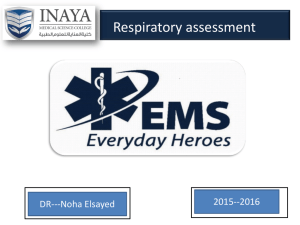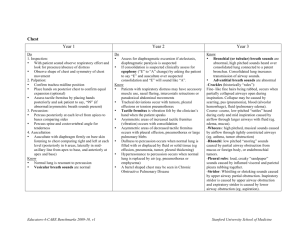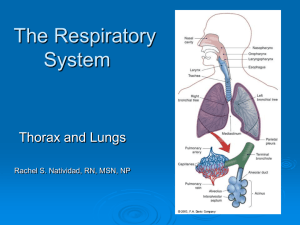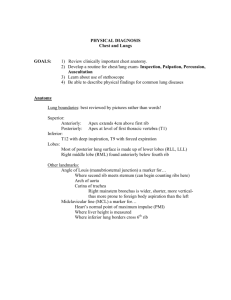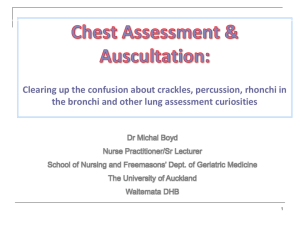Percussion & Auscultation: Chest Examination Techniques
advertisement
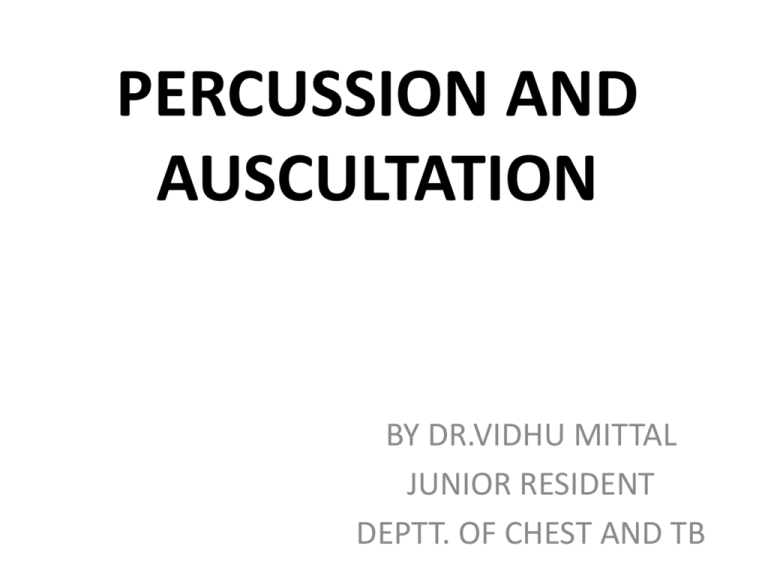
PERCUSSION AND AUSCULTATION BY DR.VIDHU MITTAL JUNIOR RESIDENT DEPTT. OF CHEST AND TB Anterior lung surface markings • REMEMBER: 2,4,6,8,10 Lungs • Each lung extends 3cm above the clavicle (apex) • Anterior borders of lungs are closest at the sternal angle – 2nd costal cartilage (cc) • Both reach to 4thcc • Left: – Moves away from the midline at the 4th cc • Right: – Moves away from the midline at the 6th cc • Both cross the midclavicular line at the 8th cc • Both cross the midaxillary line at the 10th cc Note about pleura: They have the same surface markings as the lungs but reach further down to the 12th cc REMEMBER: 2,4,6,8,10,12 Pleura Percussion Historical note Amongst the notable advances of 18th century, one is the introduction of a new method of clinical investigation i.e. percussion by “Joseph Leopold Auen brugger in 1761. It was the simple expedient of tapping the barrels of wine in his father’s cellar to determine their contents that gave Auen brugger the idea of percussion of the thorax as an aid to diagnosis, a discovery first announced in 1761, in his Inventum Novum. Definition: Percussion is a method of examination which depends on the interpretation of sounds heard and the sense of resistance encountered on subjecting the chest to a series of strokes or taps with the fingers . Main purposes of respiratory percussion : •Diagnostic Percussion. •Topographical Percussion. Methods of Percussion Direct (immediate) Indirect (Intermediate) •Where the strokes are aimed directly at the chest wall. • Percussion over bony structure. •Where the stroke are aimed at some intermediate object (e.g. a finger) applied to surface of chest wall. The other special types of percussion are: (a) Light percussion : on the clavicles is useful to determine the character of the lung substance at the apices. (b) Heavy percussion : by using two fingers instead of one or using several fingers without any intermediate finger. (c) Flicking percussion: it is useful for eliciting metallic resonance in case of pneumothorax. (d) Direct or indirect palpatory percussion: it may be used for detecting the presence of fluid or consolidation within the chest. TECHNIQUE OF PERCUSSION: Position of Patient: The patient may be percussed in the sitting, standing or recumbent position. (a) Recumbent position: best avoided (b) The standing position : tiring both to patient and examine. The position of choice is sitting up posture. IDEAL POSTURES Area to be Posture AUAUSCULTATION OF percussed RESPECTIVE Patients sits on aAREAS stool opposite the examiner a) Front wall of chest with the body bolt upright, completely relaxed and with sides symmetrical b) Back Patients bends slightly forwards with the head flexed on the chest, the shoulders sagging and the arms resting, either crossed or uncrossed, on the thighs. c) Interscapular / scapular Patient is directed to place his hands over the region shoulders after crossing the arms in front of the chest. d) Axillae Patient is instructed to put his hands over the head. AREAS OF EXAMINATION Direction of percussion: It is customary to start percussion to at the apices of the lungs comparing identical or corresponding area on 2 sides and slowly proceeding downwards. Cardinal Rules of Technique: •The pleximeter, the middle phalanx of the 3rd finger of the examiner’s left hand must be firmly applied to the chest wall, so that no air pockets are interposed between the finger and chest wall. •The ‘plesser’ which is the third finger of the examiner’s right hand, is kept flexed at a right angle and must hit the middle phalanx of the pleximeter finger perpendicularly, with the pad and not the tip of the finger. • The percussion stroke must be sudden, the plessor finger being withdrawn immediately after the stroke, to prevent a damping of the note. • The movement of percussion must originate at the wrist and not at the elbow or finger. • The force of the stroke must be varied according to the purpose of the percussion the tissue or organ being percussed , thickness of the chest wall or area of the chest wall. • Percussion should proceed from resonant to dull area or from more resonant to less resonant areas whenever possible the auditory appreciation of any change of note being better in this direction. • Whenever delineating the border of an organ, such as the heart or the liver, the long axis of the pleximeter finger must be kept parallel to the expected position of that border. • The area percussed must be more or less equidistant from the two ears of the examiner, in order to prevent wrong interpretation of sounds; the examiner must therefore directly face the centre of the patient chest, whenever possible. Types of percussion notes: Normal lung resonance (Vesicular resonance) : The normal percussion note of the chest is due to an underlying lung tissue, containing a normal amount of air in the air vesicles, air sacs and air passages which has a distinctive and clear character with a low pitch. Abnormal types of percussion notes Quantitatively different • Tympany • Subtympany •Hyperresonance •Impairment of note • dullness • stony dullness Qualitative different • Cracked pot resonance • Amphoric resonance • Bell tympany Tympany : Drum like note. When such a note in heard once a region of the chest mall, the possibility of a superficial cavity in the lung or pneumothorax should be considered. Subtympany (Skodaic resonance) : Hyperresonant note with boxy quality. heard just above the level of a pleural effusion or pneumonic consolidation . Hyperresonance: A note intermediate in pitch between normal lung resonance and tympany which can be elicited normally by percussing in full inspiration. Pathologically it can be encountered either B/L in case of emphysema. U/L in pneumothorax, large bullae or compensatory emphysema. Impaired note : When part of the lung becomes comparatively airless, it fails to vibrate sufficiently to the percussion stroke and gives rise to an impairment of note or loss of resonance. Flatness (absolute dullness) : A percussion note completely devoid of resonance a displaying absolute or extreme dullness in referred to as flat dull notes. Stony dullness: A type of absolutely dull percussion note associated with pain when percussing in the examiner’s pleximeter finger as percussing oves stone. one would experience when TYPE OF PERCUSSION NOTE SEEN IN Tympanitic Gas containing hollow viscera. Subtympany Hyperresonant Above pleural effusion or consolidation Pneumothorax Resonant Normal aerated lung Impaired Pulmonary fibrosis, sometimes consolidation or collapse. Thickened pleura, consolidation, collapse Dull Flat Pleural effusion Stony dull Massive growth in lung or pleura OTHER ABNORMAL PERCUSSION NOTES • Cracked pot resonance: tympanic resonance which is due to the sudden expulsion of air from the cavity into the bronchus through the narrow opening or communication. • Amphoric resonance: A low pitched and hollow note that can be elicited in pneumothorax or large cavity in the lung. • Bell tympany Topographic Percussion of Lungs • Percussion of the chest to determine the boundaries or extent of lungs is referred to as topographic percussion . It can be :• APICAL percussion • BASAL percussion • TIDAL percussion Apical percussion: Can be carried out in the supraclavicular fossae anteriorly by determining the upper borders of lung resonance on the two sides. •decreased/absent supraclavicular • good zone of resonance on one or evidence pulmonary tuberculosis. Both side. • increased extent of resonance bilateral suggests. •emphysema of An alternative method: Kronig’s isthmus :- which is a band of 5-7cm in width of resonance connecting the large zones of lung resonance over the anterior and posterior aspects of each side. Decreased / absent kronig’s istmus Increase in width . Suggestive of apical tuberculosis Suggestive of emphysema Basal Percussion: • Percussion of lower border of the lung necessitates light percussion anteriorly and heavy percussion at the back (because of thicker musculature) • A change of note from vesicular resonance to dullness (posteriorly, on both sides and anteriorly, on the right side). • From vesicular resonance to tympany when percussing downwards over the chest, serves to delineate the lower or basal limit of lung resonance Applied : lower border of the lung resonance tends to be depressed in case of emphysema or pneumothorax raised in case of lung fibrosis, collapsed lung, consolidation, ascites, massive abdominal tumor or pleural effusion. Tidal percussion: Percussion of the lower border of lung resonance, on each side, at the height of deep inspiration and expiration serves to determine the extent of diaphragmatic excursion. decreased or restricted movement suggests some underlying lung disease such as pulmonary fibrosis. Areas of abnormal percussion note in health: • Area of cardiac dullness. • Area of liver dullness. • Area of splenic dullness • Traube’s area. • Ewart’s sign Special Percussional findings in disease: • Reduction of both cardiac and liver dullness. • Shifting dullness. • Obliteration of Traube’s area. • William’s tracheal resonance. • Wintrich’s sign • Gerhardts’ sign • Friedreich’s sign • Lines of Demarcation • Myotatic irritability. AUSCULTATION HISTORICAL NOTE A discovery of the greatest importance in the early part of 19th century was that of auscultation with the aid of stethoscope by the French physician LAENNEC . Remembering a well known acoustic fact that “ if the ear be applied to one end of a plank , it is easy to hear a pin’s scratching on the other end .” UNAIDED EAR TYPE OF SOUND 1- STERTOROUS breathing FOUND IN coma and sleep( snoring) 2- RATTLING breathing ineffective cough due to suppression of cough reflex 3- physical and emotional stimuli- exercise , pain, cold fear , grief GASPING , GRUNTING and SIGHING 4-HISSING ( KUSSMAULS ) breathing signifies hyperventilation without dyspnoea. sign of severe acidosis as in diabetic keto acidosis 5-WHEEZING asthma 6- STRIDOR narrowing of extrathoracic airway OBJECTIVES OF AUSCULTATION • To determine whether the breath sounds are equal on both sides . • To ascertain the character of the breath sounds . • To detect any added sounds and decide their nature and whether they are intra or extrapulmonary. • To compare the voice sounds on different parts of lungs. METHOD OF BREATHING Patient is asked for forced or deep breathing , through the mouth as this increases the tidal volume sufficiently without producing additional upper airway noise or provoking hypocapnia . DEFECTIVE AUSCULTATION OF RESPIRATORY SOUNDS Auscultation may be defective if the patient is • Breathing through the nose , especially in the presence of nasal obstruction. • Breathing noisily or too forcibly giving added sounds . • Shallow breathing due to pain on breathing . • Hair on the chest produces crackling sounds which may be mistaken for lung sounds . POSITION OF THE PATIENT • Ideal posture - upright , either sitting or standing • For examination of the back – patient may lean slightly forward , with the head flexed arms crossed in front or resting on the thighs . • Examination in the recumbent position although undesirable but may be required in seriously ill patient . FEATURES TO NOTE DURING AUSCULTATION OF BREATH SOUNDS • Intensity or loudness. • Quality or character whether rustling or wheezy . • Comparison of inspiratory and expiratory elements in terms of intensity , duration or length and pitch. • Presence or absence of intermediatory pause between them . • Characteristics such as prolongation or jerky or interrupted nature . • Presence of other sounds or accompaniments FACTORS DETERMINING TRANSMISSION OF BREATH SOUNDS The intensity of the breath sounds heard through the chest wall depends on :• rate of airflow into the territory of lung under the stethoscope . • The acoustic properties of the two media namely the lung and the chest wall . Therefore.. • Transmission is almost complete between the two well matched media like consolidated lung and the chest wall ,hence the similarity between the bronchial breathing and the breath sounds heard over the trachea . • Sound is reflected at the interface between the lung and air or fluid in the pleural cavity so that in pneumothorax and in pleural effusion no breath sounds reaches the chest wall MODE OF PRODUCTION OF NORMAL BREATH SOUNDS Normal breath sounds are generated by turbulent airflow in the upper airways i.e. in the pharynx and larger airways of the lugs ( frequency range of 200 to 2000 Hz or cycles / sec per sound ) As this sound is transmitted through the lungs it is dampened ; the higher frequencies are lost and a softer , lower pitched sound ( 200 to 400 Hz ) is heard , which are the normal vesicular breath sounds. In the smaller airways airflow is slow and laminar , turbulence cannot be developed hence smaller airways acts as filter and not a source of lung sounds . TYPES OF NORMAL BREATH SOUNDS TYPE OF SOUND AREA WHERE FOUND VESICULAR Over most areas of the chest BRONCHIAL Larynx , trachea BRONCHOVESICULAR Over and around the upper part of the sternum VESICULAR BREATH SOUNDS It is characterised by active inspiration due to inflow of air into bronchi and alveoli followed without a pause by passive expiration from elastic recoil of the alveoli. QUALITY :- rustling noise louder and more prolonged in inspiration than expiration. MODE OF PRODUCTION :- It is attributed to distention and separation of the alveolar walls by the in-rushing current of air . BRONCHIAL BREATHING The less the filtering of the breath sounds the more closely will the sound approximate to its source in the trachea and bronchi i.e. is bronchial breathing . QUALITY :- higher pitched and clearer than vesicular breathing . Inspiration and expiration are of equal length or expiration is somewhat longer than inspiration and they have a distinct gap between them . MODE OF PRODUCTION :- Due to the in and out movement of the air through the narrow aperture of the glottis . The lower pitch of the sound during inspiration is due to the glottic aperture being wider during inspiration because of a wider separation of vocal cords . BRONCHOVESICULAR BREATHING Its a type of breathing intermediate in character in between vesicular and bronchial breathing . Its recognition usually depends on the nature of the expiratory sound which is louder , longer and higher in pitch than the inspiratory sound . MODE OF PRODUCTION :- it usually arises when the normal air containing lung tissue is interposed between a large bronchus and the chest wall , thus combining the characteristics of both vesicular and bronchial types of breathing . ABNORMAL BREATH SOUNDS Breath sounds may be heard abnormal due to two main reasons :ABNORMAL GENERATION ABNORMAL CONDUCTION Narrowed airways intensify the linear velocity of breath sounds and thus increasing their turbulence making the breath sounds louder . Abnormal lung will conduct the centrally generating breath sounds abnormally for e.g. consolidated lung and the overinflated lung of emphysema. ABNORMAL TYPES OF VESICULAR BREATHING ABNORMALITY PHYSIOLOGICALLY SEEN IN PATHOLOGICALLY IN 1- Exaggerated or loud breath sounds • children •Thin chested individuals •In women Bilaterally in states of dyspnoea or bronchitis unilaterally in pulm. Tb or compensatory emphysema 2-Diminished or feeble • habitual shallow breathers •During quiet breathing •Thick chest wall •obesity -Defective production of respiratory sounds --defective conduction of respiratory sounds . 3-Absent breath sounds Massive pleural effusion , pneumothorax , area of lung collapse , secondary occlusion of a bronchus ABNORMAL TYPS OF BRONCHIAL BREATHING TYPE OF BREATHING QUALITY /CHARACHTER CAN BE IMMITATED SUGGESTIVE OF BY Cavernous Low pitched with hollow character Auscultating at occipital region of skull Tubular High pitched with tubular or aspirate quality Amphoric High pitched with metallic or ECHO like quality Underlying cavity in the lung Open pneumothorax Pulled trachea syndrome Pneumonia Pulm infarction Atelectasis or collapse of lung Blowing intensely Large cavity in the across the mouth of lungs with smooth the bottle walls Pneumothorax communicating with the bronchus ABNORMAL BRONCHOVESICULAR BREATH SOUNDS METAMORPHOSING breath sounds :occasionally , the type of breathing may change suddenly in type, character or intensity during one and the same breath . It is usually due to dislodgement of a mucus plug that is partially occluding a bronchus , by the incoming rush of air during inspiration . ADVENTITIOUS (ADDED) SOUNDS Chest diseases can give rise to 3 types of added sounds , namely :• Wheezes • Crackles • Pleural friction WHEEZES These are continuous musical sounds caused by flow through narrowed airways . MODE OF PRODUCTION :- as air is forced past a point at which opposing airway walls are just touching ; these vibrate , generating the wheeze . TYPES OF WHEEZES:1- Fixed monophonic wheeze – this is a single note of constant pitch , timing and site . It results from air passing at high velocity through a localized narrowing of one airway . Bronchial carcinoma is the commonest cause 2 Random monophonic wheeze :- these are random single notes which may be scattered and overlapping throughout inspiration and expiration and are of varying duration , timing and pitch . They signify widespread airflow obstruction as in asthma or bronchitis . POLYPHONIC WHEEZES • Expiratory polyphonic wheeze :-it results from the oscillation of several large bronchi simultaneously brought to the point of closure by congestion of the mucus lining , contraction of smooth muscle and thickening of layer of mucus . E.g. in asthma and COPD. • SEQUENTIAL INSPIRATORY WHEEZES ( SQUAWKS ):- A series of sequential but not overlapping inspiratory sounds or occasionally a single sound , resulting from opening of airways which had become abnormally apposed during previous expiration . They tend to occur in deflated areas of lung and hence are heard in lung fibrosis , especially fibrosing alveolitis . a) Fixed monophonic wheeze b) Random monophonic wheeze c) Expiratory polyphonic wheeze d) Sequential inspiratory wheeze(squakes) CRACKLES Crackles result from the explosive equalization of gas pressure between two airway compartments when a closed section between them suddenly opens . Expiratory closure of airways is gravity dependent , so that crackles are mainly basal in site . Classification of crackles Acc. to timing & character Conventional Early inspiratory Coarse Late inspiratory Fine Expiratory EARLY INSPIRATORY CRACKLES :• Are coarser • Come from larger airways so pattern is same over different parts of the lung . • are scanty , audible at the mouth and not posture dependent. LATE INSIPIRATORY CRACKLES • Are due to restrictive conditions of the lung resulting in expiratory closure of small peripheral airways with re-opening at the end of inspiration . • Come from smaller airways so have fine pattern and varies over small areas of the lung . • Dependent on the gravitational forces on the lung so best heard at lung bases where the small airways close on expiration. EXPIRATORY CRACKLES • They arise by re-opening of the airways , temporarily closed by the trapping mechanism as air is redistributed distal to larger and more proximal airways narrowed by the trapping mechanism during expiration . • They are characteristic of severe airway obstruction . COVENTIONAL CLASSIFICATION OF RALES 1. COARSE CRACKLES :- they originate within large bronchial tubes and are heard equally in inspiration and expiration. . Are often altered with coughing and can be heard over segments and lobes affected with bronchiectasis. . May also be heard at the mouth without stethoscope and are caused by air bubbling through collections of mucus or pus in areas of bronchiectasis. FINE CRACKLES • Are due to sudden separation of sticky alveolar walls , at the end of inspiration by the inrushing of air . • These lack the bubbling quality of coarse crackles and have “crackling” quality . • These may be artificially imitated by rubbing a lock of hairs between the finger and the thumb. PLEURAL RUB ( PLEAURAL FRICTION ) Definition :- oscillations arising from the frictional resistance between two layers of inflammed or roughened pleura produce a creaking sound ; the pleural friction rub . SITE OF AUSCULTATION :- commonest site is lower part of axilla as movement of two layers of pleura is maximum in this area . CHARACTERISTICS OF PLEURAL RUB • • • • • • Rubbing or creaky in quality Interrupted or jerky in nature Loud and superficial Audible during both phases of respiration Unaltered after bouts of cough Usually confined to small or localized area on chest. • Usually associated with pain and tenderness. PLEURAL RUB AND CRACKLES : COMPARISION PLEURAL RUB • Superficial and loud . • Continuous sound. • Heard over a localized area. • Remains unaffected by coughing. • Pressure of chest piece of stethoscope intensifies the sound. • Associated with pain or local tenderness. CRACKLES • Not so superficial and loud • Interrupted sound • Heard over a wide area • Intensified or abolished by coughing • Pressure of chest piece produces no effect • No pain or local tenderness MISCELLANEOUS SOUNDS AND SIGN 1. Succussion splash:- Splashing sound heard when the chest of the patient is shaken suddenly by the examiner . It can be seen in •Herniation of stomach or colon into the thoracic cavity •Hydro or pyopneumothorax 2. Clicking sounds :- A small left sided pneumothorax may at times give rise to clicking sounds in tune with the heart beat. 3. Mediastinal crunch :- it may result from sudden movement of air by the systolic contraction of the heart or sudden contact and separation of the two pleural layers . Seen in . mediastinal emphysema bullous emphysema of lingula 4. Forced expiratory time :- normally it takes less than 4 seconds . A value of 6 seconds or more indicates airway obstruction. VOICE SOUNDS ( VOCAL RESONANCE) • It is the auscultatory equivalent of the palpatory phenomenon of tactile vocal fremitus . • MODE OF PRODUCTION :- vibrations initiated by the spoken voice or whispered voice are transmitted along the air passages and through the lung parenchyma to the chest wall , resulting in certain auditory or auscultatory sound phenomenon refered to as either spoken voice sounds or whispered voice sounds. SPOKEN VOICE SOUNDS ( CONDUCTED) TECHNIQUE :- while auscultating the patient is made to repeat over and over again , in a slow, loud, uniform and deep voice some phrase such as ‘ninety-nine’ or ‘ one-one-one’ or ‘one-two-three’. Normal – sounds heard are weak , muffled and indistinct with blurred and indistinguishable individual syllable. • Physiological variations :- depends on factors like 1. age 2. sex 3. state of nutrition • Regional variations :. Louder on right than left . Louder anteriorly than posteriorly SPOKEN VOICE SOUNDS IN DISEASE INCREASED VR DECREASED VR • • • • • • • • Consolidation Infilteration of lung tissue Bronchiectasis Compensatory emphysema Partial laryngeal stenosis Thickened pleura Small pleural effusion Edema of chest wall ABSENCE OF VR ABSENCE OF PRODUCTION ABSENCE OF CONDUCTION • Deaf- mutism • Vocal cord paralysis • • • • Large pleural effusion Severe emphysema Pneumothorax Acute pulmonary edema BRONCHOPHONY When spoken voice sounds appear unduly loud , clear with individual words or syllables however remaining indistinguishable.. Its presence indicates:. Lung consolidation . Compressed lung tissue as in pleural effusion. . Tuberculous or bronchiectatic lung cavity SPOKEN PECTORILOQUY • When spoken voice sounds appear unduly loud , clear and syllabic individual words being clearly distinguishable . It may be seen in :. Large cavity in the lung communicating with the bronchus . Obstruction of a large bronchus by the tumor AEGOPHONY • When the spoken voice sounds during auscultation display a peculiar quivering , nasal quality like the “ bleating of goat “, the condition is referred as aegophony . • It can be initiated by saying ‘ ninety – nine ‘ while holding one’s nose. It may be seen in . Pleural effusion . Cavity half filled with secretion . AMPHORIC VOICE SOUNDS( ECHOING RESONANCE) • When spoken voice sounds besides being intense and clear , display a characteristic metallic , echoing sound , they are referred as amphoric voice sounds . • They may be seen in :. Large cavity with tense or rigid walls communicating with bronchus . Over open pneumothorax THE SCRATCH SIGN • It is useful in diagnosis of pneumothorax • It is elicited by placing the stethoscope at some midline position on the chest and equidistant from it on both sides the skin is scratched with finger or blunt object and the sound from the two sides is compared. • Positive sign – louder and harsher sound on the side of pneumothorax . WHISPERED VOICE SOUNDS • Sounds heard over the chest wall during the act of whispering by the patient. • MODE OF PRODUCTION :- here the phenomenon of articulation takes over the entire function of sound production . Also there is no vibratory tremor and sympathetic vibration on the part of the thoracic walls . • METHOD OF ELICITING :- patient is asked to whisper phrases like ‘one-one-one’, ‘one –twothree’. WHISPERED SOUNDS IN HEALTH IN DISEASE • Usually inaudible over normal lung parenchyma • Consolidation • Bronchopneumonia • Tuberculous infilteration WHISPERED PECTORILOQUY • It is when the whispered voice is transmitted to the chest wall with sufficient clarity and individual syllables or words being clearly distinguishable . • It may be indicative of :. Fairly large cavity in the lung communicating with a bronchus . Massive or diffuse consolidation of lung tissue overlying or adjacent to bronchus . Obstruction of a large bronchus by a tumor. SUMMARY DISEASES PERCUSSION NOTE BREATH SOUNDS VOICE SOUNDS ADDED SOUNDS CONSOLIDATIO N DULL BRONCHIAL BRONCHOPHO FINE NY INSPIRATORY WHISPERING CRACKLES PECTORILOQUY COLLAPSE DULL ABSENT OR BRONCHIAL DIMINISHED OR BRONCHOPHO NY FIBROSIS DULL DIMINSHED OR DIMISHED OR BRONCHIAL BRONCHOPHO NY NONE COARSE CRACKLES( IF BRONCHIECTAT IC) DISEASES PERCUSSION NOTE BREATH SOUNDS VOICE SOUNDS ADDED SOUNDS EMPHYSEMA HYPERRESONA NCE,, LOSS OF LIVER AND HEART DULLNESS DIMINISHED DIMINISHED EXPIRATORY WHEEZE EFFUSION FLAT OR STONY DIMINISHED DIMINISHED FRICTION RUB(IN EARLY STAGES) PNEUMOTHOR AX TYMPANY DIMINISHED OR AMPHORIC DIMINISHED METALLIC CRACKLES
